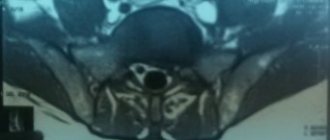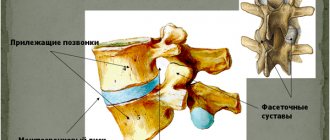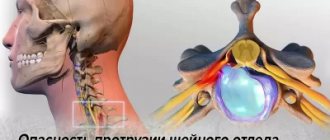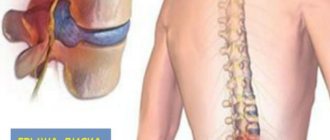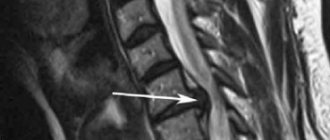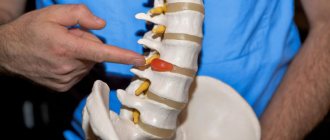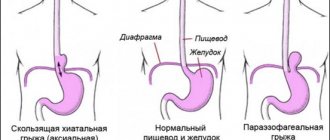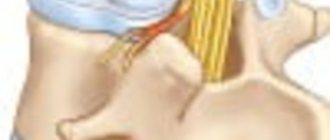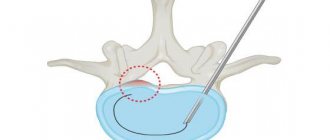- Home /
- Branches /
- Neurology /
- Intervertebral hernia
Recently, a herniated disc has become a fairly common disease that can seriously affect a person's vitality. Very often the disease is accompanied by a pinched nerve connecting one of the internal organs to the spine, which leads to disruption of its functions. Treatment of intervertebral hernia should be entrusted to a highly specialized specialist in the field of neurology.
Symptoms of intervertebral hernia
The symptoms of spinal disease have quite clear manifestations. A hernia leads to thinning of the intervertebral discs, which causes characteristic friction between the vertebrae. Such changes cause unbearable pain to a person.
The resulting hernia begins to put pressure on the nerve endings, leading to spasms and numbness of body parts. Symptoms, as a rule, vary depending on the zone of localization of the formation:
- thoracic region - difficulty breathing, pain in the heart area;
- cervical region – headaches, dizziness, numbness of the upper extremities, changes in blood pressure;
- lumbosacral region - lumbar pain, numbness of the groin area and fingers of the lower extremities.
Make an appointment with a neurologist
“The hernia itself “does not resolve.” It is necessary to undergo treatment. If therapy is carried out under the supervision of an experienced doctor in a specialized center, then the pain syndrome is quickly eliminated and degenerative changes stop. In the initial stages of the disease, complete recovery will take 1-2 years. We do everything possible to ensure that patients cope with the disease without surgery. But if the pain does not subside for several days, then surgical intervention cannot be avoided.”
Akopdzhanov Georgy Levonovich, neurosurgeon, doctor of the highest qualification category
Advantages of laser exposure
This technique has a large number of advantages, but all of them will be relevant if the patient has a small and “fresh” disc defect. What are these advantages?
The following indicators and arguments make laser methods of influencing a pathologically changed disc one of the best in our time:
- the average duration of the intervention does not exceed 45 minutes, this allows the patient to be hospitalized for only two or three days, and discharged the next day after the procedure;
- techniques have a very low number of complications, less than 0.1%;
- When performing laser interventions, it is impossible to accidentally damage roots and other structures. The patient is under local anesthesia and can always tell the doctor about unpleasant sensations, for example, that there is a feeling of “pins and needles” in the leg, or muscle twitching. This contact allows the neurosurgeon to take immediate action;
- laser methods do not leave scars on the skin, and there is no cosmetic defect;
- since there are no incisions or manipulations with the vertebrae, there is no risk of developing instability, as with a classic laminectomy;
- on the other hand, there is no risk in obtaining a fixed block, as during spinal fusion operations, which limits the patient’s mobility;
- laser methods can be used to treat hernias repeatedly in different parts of the spinal column;
- The absence of general anesthesia is very important. As a result, the procedure does not have the high risk inherent in conventional operations in the elderly, as well as with the presence of concomitant pathology;
- Laser treatment of hernias is perhaps the safest method. If necessary, it can be used even during pregnancy and breastfeeding, since anesthesia substances that can adversely affect the baby do not enter the woman’s bloodstream.
However, these methods also have certain disadvantages.
Causes of the disease
When body position changes, the intervertebral discs compress and push the ring out. If the discs are in a healthy state, no structural changes are observed. With the development of an intervertebral hernia, the nucleus pulposus of the disc is displaced and the fibrous ring is stretched (protrusion).
This is the first stage of development of an intervertebral hernia. If you do not see a doctor in time, further stress leads to rupture of the fibrous ring and prolapse of the nucleus. After this, the disease enters its destructive phase. Severe pain begins, sometimes neurological complications in the extremities are observed, and paralysis is possible.
Reasons influencing the development of pathology:
- typical back injuries;
- overweight;
- osteochondrosis;
- unsuccessful sudden movement;
- excessive stress on the spine;
- diseases associated with the destruction of bone or cartilage tissue;
- curved spine.
There are certain groups of people who have a doubled risk of developing an intervertebral herniation of any part of the spine, in particular the sacral region. This age category is from 25 to 50 years old, truck drivers who are forced to spend a lot of time behind the wheel, office workers who work for long periods at the computer.
The pressure on the spinal discs in a sitting position is much greater than when walking. With limited mobility, blood circulation in the muscular system becomes difficult, and this leads to loss of fluid reserves in the core.
Sign up for a consultation
Flaws
First of all, there is no large amount of scientific data that allows us to speak confidently about the long-term period, since the technique has been used relatively recently. No one knows how laser treatment will affect the patient's disc structure after 30, 40, or more years. Also:
- this type of treatment is not radical.
So, if we talk about disc replacement, which is carried out with great success in Western European countries, for example in the Czech Republic, Germany, then we can assume that a person receives practically a new disc and a return to freedom of movement. After laser manipulation, he is left with an old disk, and often with a changed structure; Disc replacement. - the next disadvantage is the occurrence of relapses, and sometimes there is a need for repeated intervention. But almost always such residual phenomena and the need for re-treatment are associated not with incorrect surgical technology, but with non-compliance with the rules of a healthy lifestyle prescribed by the doctor;
- sometimes, when a large volume of the disk is evaporated, the temperature of the surrounding tissues may rise too quickly. If the intervention is carried out too quickly, they can be thermally damaged. Such a burn can worsen the course of the healing period, and even lead to discomfort and pain due to fibrosis and adhesions;
- quite high cost of treatment. But in the conditions of the Russian Federation, a drawback is the fact that patients turn to neurosurgeons so late that the hernias already exceed the maximum size and structure allowed for laser correction, which serves as the main contraindication to laser treatment.
Establishing diagnosis
Diagnosis of intervertebral hernia is of key importance for choosing a treatment regimen and is carried out using the following methods:
- MRI of the spine. “Gold standard” for identifying pathological changes in muscles, ligaments and nerve structures.
- CT scan of the spine. Allows you to assess the condition of bones and soft tissues.
Ultrasound for intervertebral hernias is not the main way to diagnose spinal diseases. X-rays are prescribed only to determine the traumatic or non-traumatic nature of existing disorders.
Preparation for the procedure
First of all, the cost of one bed-day in countries with a high level of medical development is quite high, and therefore the patient performs all tests and studies on an outpatient basis. These include performing computed tomography and magnetic resonance imaging with the required resolution, ECG, general blood and urine tests, blood glucose testing, and necessary tests for HIV and syphilis.
If necessary, in the presence of concomitant chronic diseases, permission from the relevant specialists may be required. Then the therapist issues an opinion on the possibility of performing intervention on the intervertebral discs (in terms of the absence of contraindications).
The patient comes to the clinic with the appropriate neurosurgical department, and an hour and a half before surgery. Then you will have an appointment with the treating neurosurgeon, as well as an anesthesiologist, despite the absence of general anesthesia. On the eve of admission to the clinic, the patient should not eat or drink in the evening; this is a justified preventive measure. Even in the absence of general anesthesia, there may be an unpredictable reaction to the local anesthetic, such as nausea or even vomiting.
The patient then changes into sterile underwear and is taken to the operating room. About an hour after the end of the laser intervention, he is transported to the observation room, where he remains for 24 hours. You can get up and walk at the end of the first day, that is, on the day of the operation. As a rule, the patient is discharged home the next day.
Position of the patient on the operating table.
Treatment at the Clinical Hospital on Yauza
A herniated disc is usually treated surgically. At the initial stages of disease progression, conservative (non-surgical) therapy is used. Drug treatment may last several months, but the entire course gives good results. Timely adoption of measures will prevent irreversible destruction of the spinal structure and will avoid complications (urinary and stool incontinence, sensory disturbances in parts of the body, paralysis).
Treatment of intervertebral hernia with drug therapy involves the use of non-steroidal anti-inflammatory drugs. Muscle relaxants, chondroprotectors and a number of vitamins must be prescribed during treatment. In case of a sharp exacerbation of the pathological process, which is characterized by acute pain, the doctor prescribes blockades (hormonal anti-inflammatory and analgesic drugs).
In conjunction with a course of medication, physiotherapeutic procedures, massage, acupuncture and physical therapy can be prescribed. Treatment with ultrasound and electrical impulses makes it possible to relieve pain and improve tissue repair processes.
Surgical removal of a herniated disc is a radical approach to eliminating the causes of pain and neurological abnormalities. The main methods of surgical intervention: vertebroplasty, endoscopy, percutaneous discectomy, laser vaporization.
Surgical treatment of intervertebral hernia is carried out in the presence of the following indications:
- intractable pain syndrome;
- increasing neurological deficit;
- dysfunction of the pelvic organs;
- numbness of body parts, decreased potency.
The cost of treating a herniated disc in Moscow at the Yauza Clinical Hospital depends on the degree of progression of the disease and the presence/absence of complications. Check prices by calling the number listed on the website.
Make an appointment
Contraindications
There are a number of conditions where laser radiation may cause more harm than good. Laser methods for treating disc herniations are contraindicated if:
- in this segment there is an anomaly of the bone structure of the vertebrae, for example, the presence of bilateral Schmorl hernias;
- with significant narrowing or stenosis of the spinal canal at the site of the proposed intervention;
- According to an X-ray examination, MRI, there are signs of discitis in the intervertebral disc, that is, inflammation, and in the surrounding bone tissue of the vertebrae there are signs of spondylitis.
Finally, laser technology is not used in cases of sequestered hernia. It is highly undesirable to use laser methods, as mentioned above, for large hernias exceeding 6 mm. Of course, no one forbids the patient to insist on this method of treatment, but there is a risk of incomplete removal of the hernia, and especially if the patient is over 50 years old and has tears in the fibrous ring, that is, there is a high risk of repeated protrusions and hernias in this segment.
An absolute contraindication to laser treatment of hernias is displacement of the vertebrae and their severe instability, a tumor in this segment, even a benign hemangioma. The patient becomes familiar with the full list of contraindications at the initial appointment with the neurosurgeon, when the type of surgical treatment is selected. How should you prepare for laser treatment?
Sequestrated hernia on MRI.
Prevention measures
Intervertebral hernia is the result of improper loads on the spine. The conditions for the normal functioning of the spine are the preservation of its mobility and the strength of the surrounding muscles (muscle corset).
To keep your back healthy, patients are recommended to:
- Take daily walks in comfortable shoes.
- Do regular exercises to strengthen your back muscles.
- Eat properly and balanced to maintain optimal weight.
- Sleep on the right orthopedic mattress (medium, high degree of hardness).
- Maintain an optimal work and rest schedule.
Possible complications
In the vast majority of situations, the operation goes well and does not cause any undesirable consequences. They are observed in less than 0.1% of cases. However, if it is carried out incorrectly or errors are made during rehabilitation, the following may develop:
- infection of a postoperative wound, accompanied by suppuration;
- injury to nerve endings;
- the formation of rough scars that have a compressive effect on the nerves and spinal cord;
- rapid relapse of the disease.
When contacting the SL Clinic, you will not encounter such complications. But only subject to strict adherence to all recommendations received from the doctor regarding physical activity in the postoperative period. At the same time, our price for endoscopic removal of a spinal hernia is not too different from the cost of a similar service in the regions.
Operation microdiscectomy
Advantages that allow you to choose our microdiscectomy center:
- we perform the operation through a small incision of 1.5-2 cm
- surgery under PDA anesthesia (not general anesthesia - much faster recovery)
- The duration of the operation is on average 15 minutes
- At the end of the operation, we pump in a special anti-scar gel that reduces the formation of scars.
- hospitalization takes 1 day
- ability to sit, stand up and walk on the same day after surgery
- vast experience of the center’s staff in removing intervertebral hernias, guaranteeing almost 100% results
- This is a neurosurgical operation aimed at eliminating compression of the contents of the spinal canal by a herniated intervertebral disc. Microsurgical discectomy is currently considered the “gold standard” in world practice for disc herniations with compression of the roots and/or spinal cord. Microdiscectomy is a minimally invasive operation. The objective of the operation is to remove a hernial protrusion or a loose part (sequestrum) of a disc located in the spinal canal through a minimally invasive approach with virtually no damage to muscle and bone structures. After microdiscectomy, the recovery period takes only one day, and the pain syndrome after surgery completely regresses or is minimally expressed.
